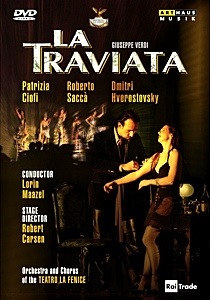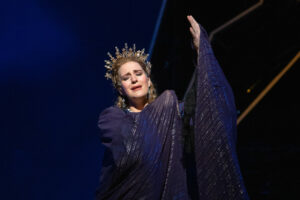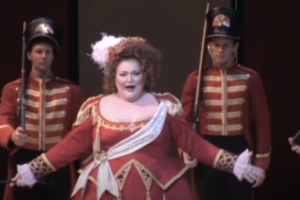
In Robert Carsen’s 2004 production of La traviata for Teatro La Fenice, the Prelude is staged. During this haunting music, we see Violetta lounging on a huge bed while more than a dozen men pay her for her services with wads of oversized dollar bills. By the time Act One begins, the bed is virtually covered in money.
As they say in television land, you could have turned your sets off right there. Virtually all of Carsen’s ideas are established before a single note is sung. He establishes that his Violetta is a prostitute rather than an elevated courtesan, and that money and sexual commerce form the basis of this story. He then proceeds to repeat the money business ad nauseam.
Violetta flings money about during “Sempre libera.” The oversize dollars fall from the trees like leaves during Act II, and completely cover the ground for the entirety of the scene. They begin falling again during “Amami, Alfredo…” Even Papa Germont gives Violetta a pile of bills. Thus, when Alfredo flings money at Violetta in Act II Scene 2, the effect is completely dissipated. I kept wanting to shout, “OK, OK, we got it in the Prelude, enough with the money already!” Adding to the heavy-handed business is the precious bit that the dollar bills have Verdi’s picture on them instead of Washington’s. And, despite the fact that the production is set in the 1970’s, the book Violetta is reading in Act II is Manon Lescaut. Really?
Arthaus Musik has released a new DVD of this production, previously issued on TDK. This is the production that opened the rebuilt Teatro La Fenice and is particularly noted for using Verdi’s original 1853 version of the opera, based on a copy of the score that had been locked away in the theatre’s archives for nearly 150 years. Hearing this 1853 version is the primary reason for seeking out this DVD. There is significant and fascinating music included, particularly illuminating in the scene between Violetta and Giorgio Germont in Act II and in the “Parigi o cara” duet in the final act. We also get to hear the second verses of all the major arias, particularly affecting in “Ah forse lui” and “Addio del passato.”
The singing, acting, conducting, and other production elements are a decidedly mixed bag. Setting the production in what appears to be late 60’s/early 70’s neither helps nor particularly harms the storytelling. It certainly allows for more groping and overt sexuality in the party scene of Act I and in Act II Scene 2, set in a rather sleazy nightclub where scantily clad cowboys and cowgirls bump and grind instead of gypsies and matadors (at least there are no dancing cows).
This setting does, however, create confusion about the nature of Violetta’s ailment. Consumption is mentioned in the English subtitles, but Carsen seems to be suggesting some sort of drug-related scenario; twice, the trenchcoated Dr. Grenvil injects her with an unidentified substance. I suppose consumption is possible, but there were plenty of good antibiotics by 1970! Another interesting set element is a painted forest drop which serves as a mural behind Violetta’s bed in Act I, as an outdoor forest in Act II, and as part of the third act.
Carsen places Violetta’s dying in Act III in what appears to be a theatre backstage area. In the end, three men (stagehands, presumably) come in with buckets of paint and the forest drop is revealed as a piece of scenery partially painted over. Carsen leaves unexplained that Violetta’s lifeless body and the weeping Alfredo, Germont, and Grenvil are completely ignored by these men.
Alfredo is presented as an almost stalkerish photographer, obsessed with Violetta’s beauty and celebrity (or perhaps popularity). This allows for touching moments in the final act when Violetta gazes sadly at Alfredo’s photos of her taken in her glory days, but it’s mainly a distraction.
Patrizia Ciofi gives a committed, complex portrayal of Violetta, though she’s never quite believable as the freedom-loving party girl of Act One. She comes into her own in Acts II-III, giving us a harrowing portrayal of Violetta’s decline. Her rather reedy soprano is used very well throughout, flexible, clear, and capable of a wide range of vocal colors. The reading of Germont’s letter and “Addio del passato” find Ciofi at her considerable best. It must be mentioned that her work in close-up suffers from her peculiar habit of forming vowels with exaggerated mouth positions that are sometimes a bit grotesque. Still, she is the grounded, gutsy center of this production, and acquits herself very well.
Unfortunately, the male performers are not up to her level. Roberto Sacca’s rather bleaty tenor is not quite up to the role, though he muscles himself through both verses of “O mio remorso” in fine style. The main problem is his very one-dimensional acting, and the fact that he lacks any sense of sex appeal. The chemistry between this Violetta and Alfredo is utterly non-existent. One could see them as congenial housemates, but certainly not as passionate lovers.
Dmitri Hvorostovsky looks terribly uncomfortable in his business suit and glasses—I got the sense that he was having a hard time fitting in to this production. He sings powerfully, but seems to be pushing for volume much of the time. There were very loud and very soft moments, but nothing of the vast area in between. Carsen also implies a sexual attraction between Germont and Violetta with some very unfatherly physical contact. Hvorostovsky seems particularly tentative in these moments.
In smaller roles, Eufemia Tufano is a frumpy but well sung Flora; Elisabetta Martorana is an unusually interesting and bright-voiced Annina.
Maestro Lorin Maazel leads the Orchestra of the Teatro La Fenice in a stirring reading of the score, and seems extremely responsive to the needs of the singers. I did think that the opening Prelude and the Prelude to Act Three lacked their usual emotional wallop; it may be because the staging is distracting.
Many of Carsen’s notions work well in this production, but he cannot seem to resist worrying them to death like a dog with a particularly beloved chew toy. This DVD is worth having for the extremely interesting 1853 version and Ciofi’s Violetta. The rest is just hit-and-miss.


























Comments